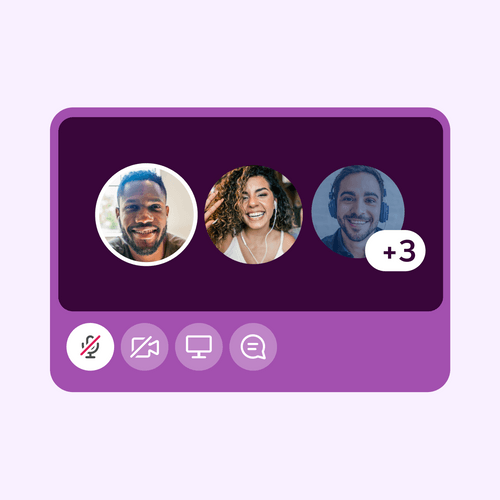If you wonder when cameras should be off or when to mute during an online call, you’re not alone. Without clear expectations for virtual meeting etiquette, distractions can derail collaboration and focus. Digital meeting rules build trust in hybrid workplaces and make it easier for employees to contribute and move work forward.
Use these tips to improve online etiquette, whether hosting or joining meetings from your home office or a business conference room.
Why virtual meeting etiquette matters in business
Clear virtual meeting etiquette can make teams more productive and work together more effectively. While business etiquette rules matter in all workplaces, forming functional team norms is especially important in remote and hybrid environments. Providing guidelines prevents misunderstandings and helps remote workers interact during digital meetings instead of merely observing.
Setting virtual meeting expectations reduces distractions that waste time and ensures equal participation, no matter where people join from. And consistently applying remote meeting rules builds professionalism and trust, key elements for collaboration in successful hybrid meetings.
Advantages of professional meeting etiquette include:
- Focus and engagement. When team members understand how to prepare for meetings and interact during them, whether that means raising their hand virtually or in a conference room, communication becomes clearer, boosting employee engagement and focus.
- Collaboration and efficiency. Offering work-from-home tips for using technology and having digital meeting rules for information sharing enhances virtual call efficiency. Teams can discuss the topic instead of fumbling with meeting controls or asking how to screen-share or save files.
- Stronger team culture. Remote meeting etiquette encourages trust-building practices like active listening while providing ground rules that set positive team norms for when to mute or keep cameras on.
Tip 1: Share the agenda and goals in advance
Simple virtual meeting etiquette, such as sharing a concise agenda, makes every call more productive. It gives attendees and presenters time to prepare and offer feedback about the meeting structure, timing, or goals. Without plans, meetings go off track or past the scheduled time.
Here are some essential to-dos:
- Create clear meeting agendas. Set virtual meeting expectations — from roles and responsibilities to what success looks like — by creating a team meeting agenda.
- Share agendas before meetings. Add agendas to discussion channels or virtual huddle boards at least 24 hours before meetings.
- Get attendee feedback. Hash out any issues before the meeting to clear the air and stay focused on the right goals when the call begins.
Tip 2: Test your technology and connection ahead of time
It’s a best practice to check your internet connectivity, hardware, and software before meetings. When virtual meeting rooms and on-site workspaces connect seamlessly, meetings start on time, have fewer distractions, and are more effective. The opposite is true when tech issues aren’t caught early.
Seventy-seven percent of workers say they’ve lost time because technical problems delayed an online meeting. Other issues, like not knowing how to download a file or unmute yourself, can disrupt brainstorming sessions. Offering support through Slack can provide chat channels for login help and a searchable knowledge base for virtual meeting tips.
Tip 3: Make sure remote participants can hear clearly
Clear audio isn’t just about stable internet and well-placed microphones. Virtual meeting etiquette prevents people from talking over others and creating distractions. When everyone’s in the same room, conversations are easier to follow. But bits and pieces can get lost or be unclear in digital sessions.
Clarify virtual meeting expectations to improve audio and help remote teams optimize their setup. Teammates may need to adjust video conferencing or huddle preferences, and hosts can add real-time transcriptions to enhance transparency.
Tip 4: Test the readability of online presentations
When sharing your screen, make sure people sitting near and far from their screens — and people using a small device or laptop — can see what you’re showing them. Attendees may be left squinting at tiny fonts and decide to tune out altogether.
Digital meeting rules for presentations suggest you should:
- View your slide deck on a laptop, tablet, and phone before sharing.
- Do a readability test by checking font size and color contrast.
- Check that any animations work well and don’t interfere with visibility or clarity.
- Enable live captions and add image alt text to any graphics to make the meeting inclusive.
Tip 5: Be on time
Punctuality shows colleagues and clients respect for time. Human resource leaders believe soft skills like professionalism will become more valuable as employees work alongside digital teammates. When everyone logs in a few minutes early and sticks to the agenda, hybrid meetings start and end on time.
To avoid late starts, consider these virtual meeting tips:
- Log in a few minutes early.
- Plan meetings around time zone differences.
- Use AI scheduling tools to find productive work times.
- Give attendees buffer time before meetings to chat in a waiting room.
Tip 6: Let others know if you won’t be on camera
Seeing each other on video can help remote and hybrid teams build stronger connections, but off days happen, and not every leader requires cameras for all calls. Practice professional meeting etiquette by dropping a note in the meeting channel or messaging the host if you can’t be on camera. Let them know you’ll still engage in thread questions or reactions.
When your team’s virtual meeting rules require cameras to be turned on, add context to explain why you won’t be on camera. Giving a heads-up allows your host to adjust activities and plan alternate engagement options.
Tip 7: Dress appropriately and check your background
Professional meeting etiquette calls for employees on video to follow company rules, which means following the in-person dress code. Business-casual outfits and clean, uncluttered backgrounds keep the focus on meeting content. It also prevents the last-minute stress of realizing something untoward shows on camera.
Different types of team meetings may have different standards. For example, project managers may relax virtual meeting expectations for casual brainstorming sessions but require professional attire for team performance assessments. Remember to keep the camera at eye level and have good lighting.
Tip 8: Make introductions and include everyone
Putting names and roles to faces or avatars builds psychological safety in online meeting spaces. It can increase trust, which can lead to meeting participants being more engaged and open to sharing ideas. Skipping intros or ignoring different communication styles keeps a wall between remote and on-site employees, eroding team dynamics.
- Establish rapport by introducing everyone. Tailor intros to your audience and meeting type, welcoming newcomers and offering quick check-ins.
- Consider an icebreaker. Try round-robin sharing when meeting with 10 or fewer people. Everyone gives a brief status update. A one-minute icebreaker poll works for larger groups.
- Invite low-pressure participation. Remind everyone of the digital meeting rules and best practices like hand raising for a turn to speak, emoji reactions for agreement, or thread replies for side questions.
Tip 9: Avoid multitasking and use active listening techniques
Your posture, facial expressions, and eye contact shape how well teammates hear, think, and work with you. If you’re typing elsewhere or getting notifications, people notice. Avoid multitasking and practice active listening techniques for more effective contributions and communications.
- Look for nonverbal cues. Know when to slow your presentation or engage your team by checking for puzzled faces, lack of eye contact, and crossed arms.
- Show engagement. Speak clearly and concisely, ask questions if you don’t understand something, use reactions or chat functions, and raise your hand.
- Eliminate distractions. Silence phone notifications, close unrelated browser tabs, and sync your status with your calendar so it automatically updates when you join meetings.
Tip 10: Be aware of when to mute yourself
Digital meetings become more efficient when individuals, presenters, and hosts know how and when to use mute. Slips might happen now and then, but if attendees regularly forget to unmute or don’t mute at all, it can affect everyone else’s focus and productivity.
Leaders can establish virtual meeting expectations so everyone knows what’s acceptable. For example, some workplaces allow small teams to have some ambient background noise. Others centrally manage mute during presentations. To practice strategic virtual meeting etiquette, use mute by default. Unmute yourself to speak, then mute after you finish talking.
Tip 11: Don’t ignore remote attendees in hybrid settings
This digital meeting rule is fundamental in hybrid environments where remote attendees may feel left out of conference room conversations. If part of your team discusses a new topic in person while a remote speaker presents or another waits to talk, it’s harder to focus and collaborate as a group.
Everyone contributes to effective project kickoff meetings and brainstorming sessions. Online meeting etiquette ensures team members respect speaking turns and stick to the topics and time allocated to them.
Tip 12: Wrap up and send a follow-up
Practice good virtual meeting etiquette by wrapping up on a clear, positive note. Summarize key decisions, action items, and due dates. Then add the next steps to your meeting channel or canvas. These steps turn a productive session into workplace momentum while keeping teams aligned on goals.
Post-meeting tasks also provide feedback and insights, which help you learn how to run effective meetings. Without prompt follow-up, time saved during the meeting goes to waste when participants forget assignments, duplicate work, or rehash the problem again on the next call.
How Slack can help you improve your virtual meetings
A lot of work goes into hosting remote meetings and events. A centralized work OS like Slack helps establish virtual meeting expectations and reinforce rules so teams can collaborate with fewer distractions.
Use Slack huddles and clips for quick async communication
When you need to solve problems faster, a quick video or audio call might be the answer. Teams can connect in huddles to chat and share screens. Slack AI captures key decisions and next steps, ensuring accountability whether meetings are planned or spontaneous.
If the information flows better over video but doesn’t need to be a meeting, try Slack clips. Pre-recorded updates work well for post-meeting follow-ups, tutorials, or virtual meeting tips.
Share agendas, action items, and follow-ups in channels and canvases
Save time and increase accessibility using Slack for pre- and post-meeting preparation. Canvases and threads keep agendas, documents, and action items in one place, while Workflow Builder automates follow-up reminders and meeting summaries.
Use Slack to:
- Draft agendas faster. Meeting agenda templates or AI agents like Agentforce speed up routine tasks, so you can get feedback before sessions begin.
- Document meeting minutes automatically. Slack’s AI features generate and share meeting minutes, summaries, and action items.
- Make agendas and goals searchable. Post online meeting rules, agendas, and minutes in Slack channels so teams find the information they need quickly using Slack AI.
- Let digital agents suggest next steps. Agentforce can improve post-meeting follow-up by reviewing meeting minutes, identifying action items, and recommending next steps.
Slack can bring all the aspects of your virtual meetings into one place and help you keep track of everything from company meeting guidelines and coordinated calendar reminders to AI summaries and automated action-item messages. Find out more about how Slack’s features can make your online meetings easier.






